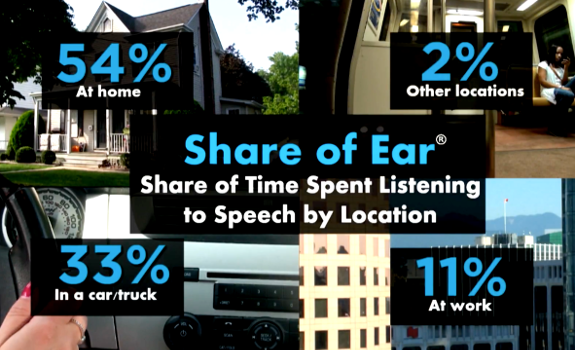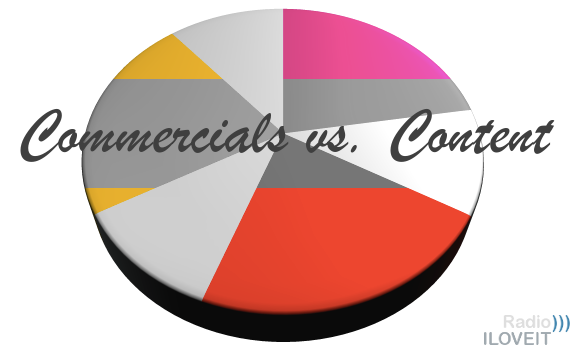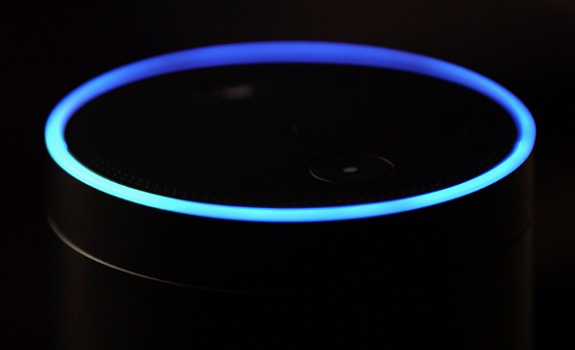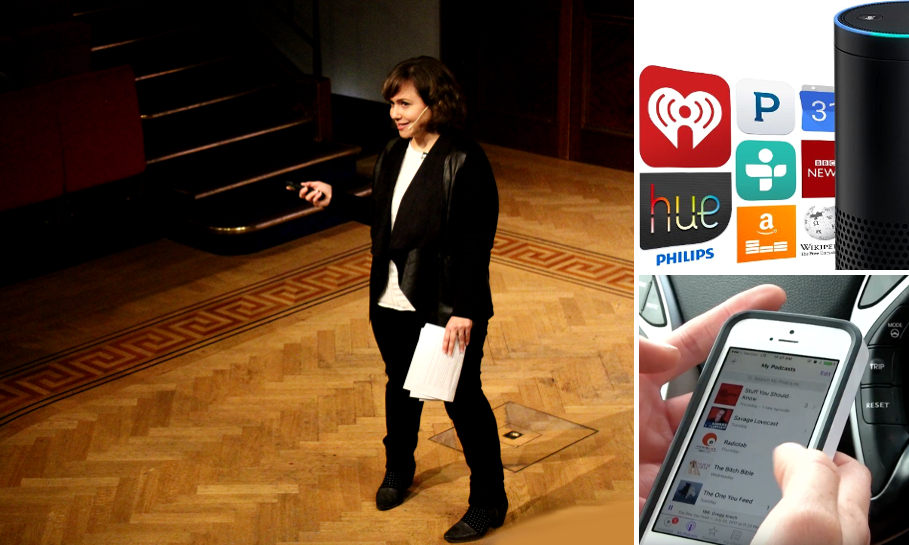How can broadcast radio benefit from podcasting popularity — reaching more listeners by targeting pod people? Universal insights from an American study.
Megan Lazovick, director of research at Edison Research, shared insights at Next Radio 2017, showing reasons why and how people listen to podcasts, what they like about it, and how radio can benefit more from the increasing popularity of podcasting. And even if your station is not based in the US, these numbers may indicate a global trend of where we are heading. Some news seems bad, but in my interpretation, we can turn challenges into opportunities!
Cars and homes are equally important locations

However, most time spent listening to speech audio happens at home (image: Edison Research)
Increase your focus groups
Lazovick introduced us to some of these “pod people” by showing reality footage of podcast fans n their twenties and thirties, from a woman listening while doing make-up (with the smartphone on the table) to a man listening in his car (connecting his smartphone to his stereo via bluetooth). To find out what people appreciate about podcasts, the research company did some face-to-face interviews with heavy podcast users, and received answers such as:
- “If I get stuck in traffic sometimes I’m excited about that, because it means I get to listen to another story or another podcast, or finish what I’m listening to” (woman)
- “Every nuance that you could imagine, there’s usually a podcast for that, so I felt like: since then, it just really expanded me as a person” (woman)
- “I had opinions on certain things, and I thought like: how could anybody see it any different, and then I listened to these podcasts, and then I’m like: this comes out from a whole different angle, and now I can see why somebody’s doing this other thing, or believes this other way” (man)
Know your audience behaviour
Edison Research and Triton Digital’s mutual Infinite Dial 2017 study shows that an estimated 168 million (60% of all) Americans are now familiar with the term podcasting, while about a quarter of all Americans actually listens to podcasts.
In a study called Share of Ear, Edison and Triton research how listeners consume audio in terms of time, location, platform and device, and whether they listen to speech or to music. It’s based on a ‘nationally representative survey of Americans 13+’ delivering data from ‘6,500 one-day audio diaries’, including people without access to the Internet for this survey (giving them a paper diary). There is absolutely potential for podcasts and other speech content, as currently:
- 86% listen to music each day
- 41% listen to speech each day
- 75% of audio listening time goes to music
- 25% of audio listening time goes to speech
- Develop your speech-only content
Change your production workflow
“If you’re a podcaster, this [25% listening time to speech] is your market share. You need to think about speech audio and music as two completely separate tracks”, Megan Lazovick advises. The people who listen to speech each day, do what you would expect: they spend less than the average audio listening time on music (53% instead of 75%), and more than the average audio listening time on speech (47% instead of 25%), in other words: those who like speech audio, spend almost half of their audio listening time on that.
It goes to show that people’s cars and homes are the most-used locations for listening to speech audio, and they’re also equally important places (both get a 58% score). Work and other locations have much lower scores. In terms of listening time to speech audio, people’s homes are leading location to listen to speech content (54% of time spent listening to speech audio, with the car being number 2 with 33%). It’s also interesting to see when people are listening to speech content, which is actually… not very different from what we see in broadcast radio:
59% podcasts, 24% AM/FM

Young Americans who listen to podcasts, listen more to it than to radio (image: Edison Research)
Optimise your mornings & afternoons
The above graph shows which percentage of Americans 13+ are listening to speech audio during each hour of the day on average, clearly indicating a peak during the same time where radio morning shows engage the most listeners, peaking around 7 am. Then there’s a smaller peak in the 3-4 pm hour, or (early) afternoon drive. Based on share of time spent listening to speech, it looks pretty good for analog terrestrial broadcast radio in the US, but podcast is second already:
- 69% AM/FM
- 11% podcast
- 7% Sirius XM
- 7% audiobooks
- 4% streaming audio
- 2% other audio sources
Target your future audience
It’s a common perception that young people mostly listen to music and less to speech, and that talk radio station have an older audience than most music radio brands, but that doesn’t seem to be the case when looking at the share of speech among Americans 13+ that goes to podcasting. The following numbers indicate that it’s relevant to create interesting content for podcasts connected to your radio station or radio show indeed:
- 25% for 13-34 year-olds
- 9% for 25-54 year-olds
- 2% for 55+-year-olds
Engage your younger listeners
“Younger Americans are listening to a lot more speech through podcasts than older Americans. This gives you an idea of where things are going in the future”, Lazovick says. To me, that means radio should offer podcasts appealing to 13-34 year-old listeners, also because her next slide shows that American 13+ podcast listeners (a large chunk being 13-34) already spend more than twice the amount of time listening to speech on podcasts compared to AM/FM radio:
- 59% podcasts
- 24% AM/FM radio
- 7% audiobooks
- 5% streaming audio
- 4% Sirius XM
- 1% other audio sources
“Ten minutes of audio, five minutes of commercials”

This is how (former) listeners perceive stopsets between content segments (image: Thomas Giger)
Podcast your show highlights
Edison Research also asked people why they’ve switched to podcasts. “I was a Howard Stern fanatic; it was all I’ve listened to for the first couple of hours in the morning”, a male participant says. “I got overwhelmed in keeping track of the show. I was like: I’m going to stop that, and I brought in the podcasts.” So while high-profile personalities can attract listeners with long-form shows, they should also offer short-form content through podcasts, creating multiple ways to listen.
“I still listen to FM radio”, he continues, indicating it is temporary. “I want to get a new car at some point, so I’m not going to put in a new stereo when my car is older. So I still listen to FM radio on the car, but if I had a different car with a different stereo, that would probably go away.”
Redesign your spins & stopsets
Several interviewees indicate that the amount of commercials (on American radio) are a major turn-off. “I have to do all these different steps now to get my podcasts to play through my USB port, and until I figured out what I needed to do to get it to work, I was stuck listening to the radio for like a couple of days in the morning, and it was terrible.” This former listener is brutally honest about her reasons to abandon radio, basically telling us that it’s more essential than ever to rethink song rotations and fix commercial breaks.
“It’s all the same songs over and over again, and if you get into a cycle where all stations are playing the same thing, and then all are going to commercials… I know I’m never coming back from podcasts.” Another interviewee says: “I hated talk radio. There was so much commercials… especially at News-Talk. For ten minutes of audio, you’ve got like five minutes of commercials! I don’t know if that’s an exact ratio, but it felt like fifty-fifty, hahaha.”
Make your content exciting
Once they’ve found a channel that offers engaging speech, several podcast listeners don’t really miss the music, so they say. “I definitely listen to music less”, a young woman states. “Sometimes I find myself like needing that extra boost that I would get from music, but I almost preferentially listen to podcasts now. There’s so many to listen to that any available bit of time, I’ll choose podcasts; get as much in as I can.”
So is speech-based radio going to do better than music-driven radio? Not necessarily: “I think that with podcasts, people are able to take risks, and explore some subjects that may be not be appropriate, or there might be some anxiety about broadcasting it live over the radio, so I do think that some of the topics they tackle [in podcasts] are more in depth or more personal than they might have been elsewhere on the radio”, a female podcast listener says.
“Really an opportunity for podcasting”

Smart speakers, like Amazon Echo, create new ways of in-home audio listening (image: CNN)
Leverage your positive reviews
With so much choice available, discovery becomes important; you want to make sure people can find your podcast. Some of the interviewees in the Edison Research study say that they’re actively looking on social media like Facebook, aggregator sites like Reddit, or distribution platforms like Google Play (or Apple’s iTunes). Another way of discovering podcasts is reading about them on websites, or hearing about them in… podcasts! “Podcasts will talk about other podcasts, and there’ll be advertising on other podcasts; if you like this, you might like that”, a user says.
You want to build a good image by getting good references. Based on several interviews, positive recommendations from trusted people seem to be a huge reason to subscribe to a podcast: “Word of mouth is big”, a young female says. “People know I like listening to podcasts… so if they find something before me, my friends are excited to tell me.” First impressions count on distribution platforms; you want to get many stars: “I’ll go to the higher-rated ones”, the same woman says. “The rating does influence me, because there’s a lot out there, and it’s hard to give everybody a listen.”
Give your audience infotainment
It’s evident that podcast producers should combine fun entertainment with valuable takeaways. “I like to listen to podcasts because I enjoy it, and sometimes I listen to stuff that’s industry-related, so I get to educate myself on stuff that can help my business”, a male podcast listener explains. “They’re just like really entertaining”, another young man smiles. “The stuff I listen to for the most part… it’s like entertaining, but also like: you learn something new.”
“They’re a great way to expand the minutes of your day by learning something new, or trying something new, and I know that really forms my behaviour patterns, maybe in some of the ways that I relate to friends and my family”, a female pod fan says. “I’m able to really tailor the topic that I’m interested in hearing more about, or the type of coverage I want, the subject areas they look at, even whether I’m in the mood for something humorous or more serious or want to learn something. So I’m really able to curate my day, and what I want to hear.”
Unite your community together
Research participants also feel like a good podcast can make people feel like being part of a group around their specific interest. “If you follow one sports team, for instance, you can find so many podcasts about that one team that cater to every part of it”, a male interviewee says. He smiles when saying: “It’s really nice, because it feels like you’re being part of a community.” In other words, he says what we, as radio broadcaster, should be doing (even more of). Presenter Megan Lazovick closes her presentation with a couple of focus points for (radio) podcast producers:
- Explain content (not tech) — former challenges with downloading & syncing podcasts have disappeared. “A lot of that friction has gone away, and we really just need to focus our messaging on the content, because people love it.”
- Push (not discovery) — as podcast listeners are vivid fans, they will surely tell others and actively look around. “My colleague Tom Webster likes to say that discovery is a pull strategy; podcasting needs a push strategy; the general public needs some explanation of the benefits of podcasting. ”
- Embrace ‘social audio’ — inspired by the Smart Audio Report, get on people’s smart speaker. “People are listening to audio differently in their homes with the smart speaker. For the first time in years, we’re seeing people ‘gather around the radio’, almost like it’s the 1930s.”
She sees a lot of possibilities for social audio. “This is really exciting for anyone in digital audio; there’s ramifications here for the type of content that you can develop for this space, and this is really an opportunity for podcasting as well.”
Header images: Next Radio, Amazon, Edison Research






Add Your Comment